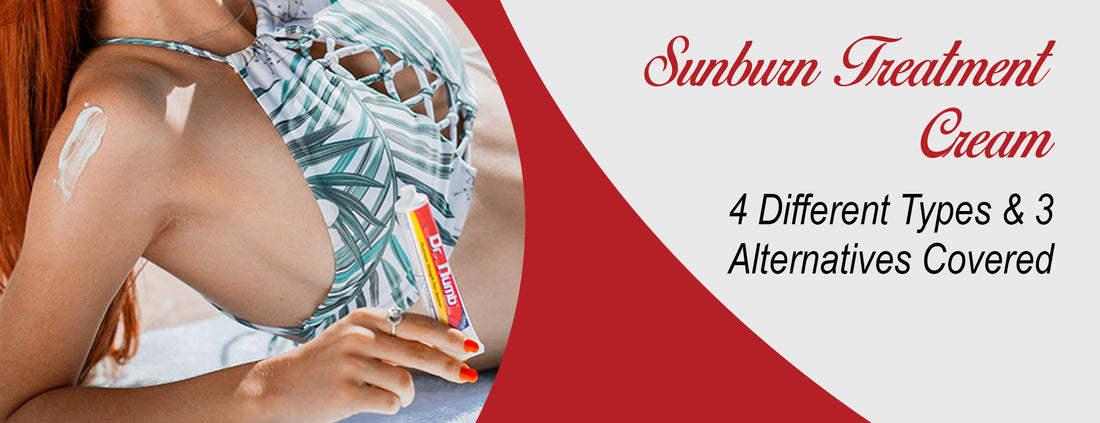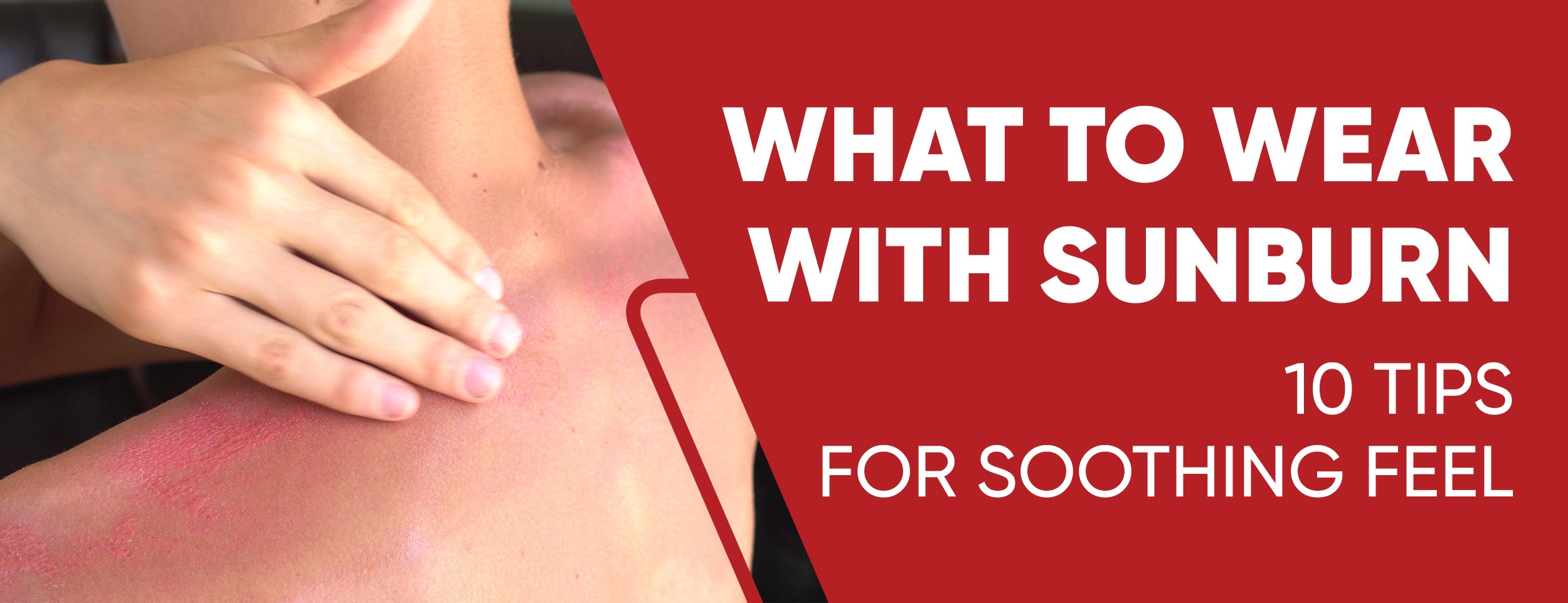You'll need a soothing medicated cream. Use nonprescription 1% hydrocortisone cream 3 times daily for 3 days if you have mild to moderate sunburn. Put the product in the fridge to cool it down.
Prolonged exposure to the sun's harmful UV rays can lead to painful sunburns that can damper all the fun. Fortunately, many sunburn treatment creams are available to help soothe and heal your skin.
This blog post will discuss everything you need to know about choosing the best sunburn treatment cream, the types of creams available, and natural alternatives.
Sunburn Treatment Cream: 4 Different Types

Sunburn can be an uncomfortable and painful experience, but fortunately, various sunburn treatment creams are available to help soothe your skin and promote healing. We will explore different types of sunburn treatment creams, how they work, the recommended dosage and application methods, and potential side effects to be aware of.
Cortisone Cream
Cortisone cream, a commonly used sunburn treatment, contains corticosteroids that can alleviate inflammation and itching associated with sunburn. Here's what you need to know about it:
- How it works: Cortisone cream reduces inflammation by suppressing the body's immune response and preventing the release of inflammatory substances.
- Dosage and application: Follow the instructions provided on the product packaging. Generally, apply a thin layer to the affected area 2-3 times daily.
- Possible side effects: Be cautious of side effects such as skin thinning, burning, or itching. If you experience severe reactions, discontinue use and consult a healthcare professional.
Hydrocortisone Cream
Hydrocortisone cream is another over-the-counter option for sunburn relief. Here's a closer look:
- How it works: Hydrocortisone cream contains a milder corticosteroid that helps reduce redness, itching, and swelling caused by sunburn.
- Dosage and application: Apply a thin layer to the affected area as directed on the product label, usually up to four times daily.
- Possible side effects: While hydrocortisone is less potent, it can still lead to skin thinning or irritation with prolonged use. Consult a healthcare professional if side effects persist.

Silver Sulfadiazine Cream
Silver sulfadiazine cream is typically used for treating burns, including severe sunburns. Here's what you should know:
- How it works: This cream contains silver sulfadiazine, which has antimicrobial properties to prevent infection and promote healing.
- Dosage and application: Apply a generous layer to the affected area, covering it with sterile gauze. Reapply as recommended by a healthcare professional.
- Possible side effects: Some individuals may experience allergic reactions or skin discoloration. If you notice any adverse effects, consult your healthcare provider.
Sunburn Treatment Steroid Cream
Sunburn treatment steroid cream is a potent option that a healthcare professional may prescribe. Here's the lowdown:
- How it works: These creams contain more potent corticosteroids to rapidly reduce inflammation and discomfort associated with severe sunburn.
- Dosage and application: Follow your healthcare provider's instructions closely, as these creams are often used for short periods to minimize side effects.
- Possible side effects: Be vigilant for side effects, including skin thinning, stretch marks, and more. Only use under medical supervision.
Natural Sunburn Treatment Cream: 3 Alternatives
Sunburn can be a painful experience, but relief may be closer than you think. Natural alternatives can offer soothing relief without the use of traditional creams. In this section, we'll explore three effective natural remedies for sunburn: Aloe vera, Chamomile tea, and Coconut oil.
Aloe Vera

Aloe vera is a popular natural remedy for sunburn and other skin irritations. Here is how it works:
- Aloe vera has potent anti-inflammatory and antioxidant properties that help relieve pain and inflammation caused by sunburn.
- It also reduces redness, swelling, and itchiness associated with sun-damaged skin.
- Aloe vera is known for its moisturizing properties, which can help prevent peeling and promote faster healing of the affected skin.
Dosage and Application
- You can extract the gel from aloe vera leaves and apply it directly to the affected area.
- If you use a pre-packaged aloe vera product, ensure it contains at least 70% Aloe vera gel.
- Apply the gel to the affected area several times daily for the best results.
Possible Side Effects
- Aloe vera is generally safe for topical use, but some people may experience allergic reactions such as itching or hives.
- Always do a patch test before using aloe vera to ensure you are not allergic to it.
Chamomile Tea
Chamomile tea is a calming herbal infusion for various ailments, including sunburn relief. Here is how it works:
- Chamomile tea contains flavonoids and terpenoids with anti-inflammatory, antioxidant, and analgesic properties.
- These properties help reduce sunburn pain, swelling, and redness, quickly relieving the affected area.
- Chamomile tea can help restore the skin’s natural moisture, promoting faster healing

Dosage and Application
- Brew a cup of Chamomile tea and let it cool down.
- Dip a clean cloth or gauze into the tea and apply it to the affected area for 15-20 minutes.
- Repeat the process several times a day until the sunburn heals.
Possible Side Effects
- Chamomile tea is generally safe, but some people may experience allergic reactions such as hives and rashes.
- You may need to avoid Chamomile tea if you are allergic to plants in the Asteraceae family (such as ragweed and chrysanthemums).
Coconut Oil
Coconut oil is a versatile natural remedy for various purposes, including sunburn relief. Here is how it works:
- Coconut oil has anti-inflammatory, antioxidant, and moisturizing properties that help soothe and heal sunburned skin.
- It can help reduce redness, peeling, and itchiness and prevent secondary infections in the affected area.
- Coconut oil can help restore the skin’s natural elasticity, making it less prone to sun damage in the future.
Dosage and Application
- Apply a thin layer of Coconut oil to the affected area and massage gently.
- Repeat the process several times a day until the sunburn heals.
Possible Side Effects
- Coconut oil is generally safe for topical use, but some people may experience allergic reactions such as itching or rashes.
- Always do a patch test before using Coconut oil to ensure you are not allergic to it.
Sunburn Treatment Cream: Choosing The Right One

When choosing the correct sunburn treatment cream, consider factors that can significantly affect your recovery and comfort. Let's explore critical considerations and top-performing creams.
Factors to Consider
- Severity of Sunburn: Assess the degree of your sunburn, whether it's mild, moderate, or severe. The severity will dictate the strength of the cream you need.
- Skin Type: Different skin types react differently to sunburn treatment creams. Consider whether you have sensitive, dry, oily, or combination skin, and choose a product that suits your skin type.
- Active Ingredients: Pay close attention to the active ingredients in the cream. Some aspects, like aloe vera, hydrocortisone, or lidocaine, can provide relief, while others may be more suitable for specific skin types.
- Allergies: If you have known allergies or sensitivities, carefully check the ingredients list to ensure no potential allergens in your chosen cream.

Top-Performing Sunburn Treatment Creams
Now that you know the critical factors, let's explore some of the best sunburn treatment creams available based on reviews and effectiveness.
- Reviews and Ratings: Look for creams with high customer ratings and positive reviews. This can provide valuable insight into the cream's performance and user satisfaction.
- Effectiveness Based on Active Ingredients: Consider the active ingredients in each cream and how they align with your specific needs. Some ingredients may provide faster relief or promote skin healing.
- User Experience and Recommendations: Seek recommendations from friends, family, or online communities who have experience with sunburn treatment creams. First-hand experiences can help you make an informed decision.
Conclusion
Summer is a time when you should take good care of your skin because it is easier to get sunburned and cause long-term damage. Sunburn can be debilitating, causing pain, swelling, and redness, but many different sunburn treatment creams are available to help soothe and speed up the healing process.
Whether you choose natural alternatives or prescription treatments, the key is to find the best sunburn treatment cream for your skin and the level of damage caused. Always take preventive measures, including using broad-spectrum sunscreen, wearing a hat, and avoiding peak sun exposure to maintain healthy and beautiful skin all year.













![How to Cover Sunburn With Makeup: 15 Ideas [Easy Solutions]](http://drnumb.com/cdn/shop/articles/How_to_Cover_Sunburn_With_Makeup__15_Ideas_Easy_Solutions.jpg?v=1705581434)

